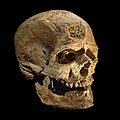Carl Linnaeus (redirect from Homo sapiens asiaticus luridus)
found. Linnaeus's remains constitute the type specimen for the species Homo sapiens following the International Code of Zoological Nomenclature, since the...
122 KB (13,442 words) - 20:59, 17 April 2025
Human taxonomy (redirect from Homo sapiens sapiens)
humans are classified as subspecies to Homo, differentiated, according to some, from the direct ancestor, Homo sapiens idaltu (with some other research instead...
35 KB (5,139 words) - 01:00, 17 April 2025
Early modern human (redirect from Anatomically modern Homo sapiens)
anatomically modern human (AMH), are terms used to distinguish Homo sapiens (sometimes Homo sapiens sapiens) that are anatomically consistent with the range of phenotypes...
115 KB (12,602 words) - 23:44, 27 March 2025
Mongoloid (redirect from Asiaticus luridus)
thesis was that Homo erectus had already been divided into five different races or subspecies. "Homo Erectus then evolved into Homo Sapiens not once but...
43 KB (4,452 words) - 06:56, 21 April 2025
animals and thus not ruling over nature. He distinguished humans (Homo sapiens) from Homo troglodytes, a species of human-like creatures with exaggerated...
35 KB (2,271 words) - 03:25, 8 February 2025
significance because all living humans belong to the same subspecies, Homo sapiens sapiens. Since the second half of the 20th century, race has been associated...
210 KB (23,434 words) - 11:02, 29 March 2025
European early modern humans (EEMH) were the first early modern humans (Homo sapiens) to settle in Europe, migrating from western Asia, continuously occupying...
159 KB (19,606 words) - 11:59, 18 April 2025
nails; and they eat fruits. Homo Homo sapiens Homo americanus Homo europaeus Homo asiaticus Homo afer Homo monstrosus Homo troglodytes – partly based on...
18 KB (1,657 words) - 17:50, 21 March 2025
was a proponent of multiregional origin of modern humans. He divided Homo sapiens into five main races: Caucasoid, Mongoloid (including Native Americans)...
139 KB (16,973 words) - 01:06, 22 April 2025
Subfamily Aesalinae Tribe Aesalini Genus Aesalus (Fabricius, 1801) Aesalus asiaticus Lewis, 1883 Aesalus himalayicus Kurosawa, 1985 Aesalus imanishii Inahara...
17 KB (1,106 words) - 01:06, 8 January 2025
towards global warming, the expansion of anatomically modern humans (Homo sapiens) to all emerged land masses, the appearance of agriculture and animal...
303 KB (19,718 words) - 01:23, 20 April 2025
Anopheles bulkleyi Causey 1937 Asiaticus Group (Reid, 1968) Anopheles annandalei Prashad 1918 Anopheles noniae Reid 1963 Asiaticus Subgroup (Rattanarithikul...
56 KB (5,627 words) - 06:15, 7 April 2025
bloodroot, Sanguinaria canadensis sanguinis sapiens L wise recent subspecies of humans: Homo sapiens sapiens ("wise wise man") saponaria L soapy soapworts...
158 KB (789 words) - 11:00, 18 April 2025
Medicine. "Serine rich and transmembrane domain containing 2 (SERTM2) [Homo sapiens (human)], Gene". Retrieved 28 September 2023. Pereira, Isabela T.; Gomes-Júnior...
14 KB (1,065 words) - 18:03, 12 December 2024
personally engaged in the prosecution of the Scipiones (Africanus and Asiaticus) for corruption, it was his spirit that animated the attack upon them...
53 KB (6,738 words) - 00:09, 9 April 2025
females, respectively, larger than the parameters of modern humans (Homo sapiens) (68.5 kg (151 lb) and 59.2 kg (131 lb) for males and females, respectively)...
399 KB (41,742 words) - 10:30, 21 April 2025
extinction of the taxa in this list was coincident with the expansion of Homo sapiens beyond Africa and Eurasia, and in most cases, anthropogenic factors played...
65 KB (6,268 words) - 02:49, 24 April 2025
shared a suite or pattern of dental developmental characteristics with Homo sapiens, is published by Modesto-Mata et al. (2020). A study on the morphology...
273 KB (25,822 words) - 15:56, 7 March 2025
by Charlier, Gaultier & Héry-Arnaud (2019). Fossils of early humans (Homo sapiens) are described from the Middle Stone Age site of Jebel Irhoud (Morocco)...
249 KB (23,358 words) - 15:43, 7 March 2025









